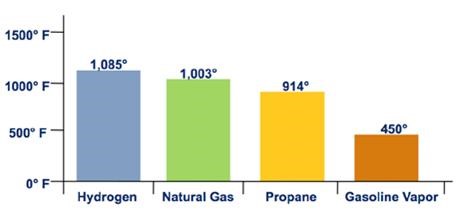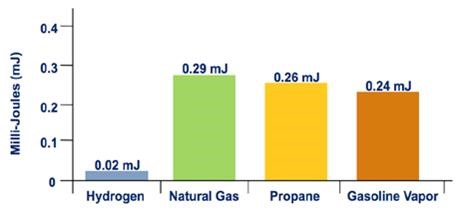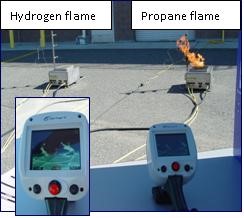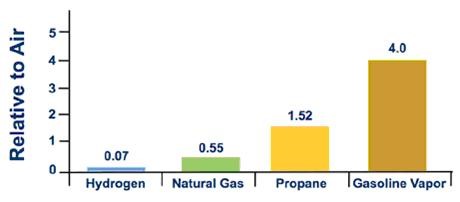- Home
-
Resources
- Center for Hydrogen Safety
- Hydrogen Safety Panel
- Hydrogen Fuel Cell Codes and Standards
- Web-based Toolkits
- Learnings & Guidance
- Paper & References

- Contact
- About H2Tools
- Welcome to the Hydrogen Tools Portal
- helpdesk@h2tools.org
Hydrogen Compared
with Other Fuels
Hydrogen: A Safe and Versatile Fuel for Today's Needs
Hydrogen Compared with Other Fuels
Like gasoline or natural gas, hydrogen is a fuel that must be handled properly. It can be used as safely as other fuels when guidelines are followed.
Produced by the U.S. Department of Energy, the Hydrogen Analysis Resource Center provides useful data on hydrogen properties, including:
- Chemical characteristics of hydrogen (e.g., density, flammability range, boiling point characteristics, heating values)
- Comparisons of the characteristics of hydrogen and many other fuels.
Bar charts presented in the following sections compare some key properties of hydrogen with those of natural gas, propane, and gasoline vapor.
Gaseous Hydrogen
Hydrogen is colorless, odorless, tasteless, non-toxic, and non-poisonous. It’s also non-corrosive, but it can embrittle some metals. Hydrogen is the lightest and smallest element and is a gas under atmospheric conditions.
Natural gas and propane are also odorless, but industry adds a sulfur-containing odorant so people can detect them. Currently, odorants are not used with hydrogen because there are no known odorants light enough to "travel with" hydrogen at the same dispersion rate. Current odorants also contaminate fuel cells, which are an important application for hydrogen.
Hydrogen is about 57 times lighter than gasoline vapor (as shown in Figure 1) and 14 times lighter than air. This means that if it is released in an open environment, it will typically rise and disperse rapidly. This is a safety advantage in an outside environment. For indoor applications, it means that hydrogen will concentrate at the ceiling.
Figure 1. Relative Vapor Density
Hydrogen is a very small molecule with low viscosity, and therefore prone to leakage. In a confined space, leaking hydrogen can accumulate and reach a flammable concentration. Any gas other than oxygen is an asphyxiant in sufficient concentrations. In a closed environment, leaks of any size are a concern, since hydrogen is impossible for human senses to detect and can ignite over a wide range of concentrations in air, as discussed in the section below. Proper ventilation and the use of detection sensors can mitigate these hazards.
Hydrogen has a high energy content by weight, but not by volume, which is a particular challenge for storage. In order to store sufficient quantities of hydrogen gas, it's compressed and stored at high pressures. For safety, hydrogen tanks are equipped with pressure relief devices that will prevent the pressures in the tanks from becoming too high.

Figure 2
Auto Ignition Temperature

Figure 3
Flammability Range

Figure 4
Minimum Ignition Energy
Hydrogen Combustion
The auto-ignition temperature of a substance is the lowest temperature at which it will spontaneously ignite without the presence of a flame or spark. The auto-ignition temperatures of hydrogen and natural gas are very similar. Both have auto-ignition temperatures, much higher than that of gasoline vapor, as shown in Figure 2.
Hydrogen's flammability range (between 4% and 75% in air) is very wide compared to other fuels, as shown in Figure 3. Under the optimal combustion condition (a 29% hydrogen-to-air volume ratio), the energy required to initiate hydrogen combustion is much lower than that required for other common fuels (e.g., a small spark will ignite it), as shown in Figure 4. But at low concentrations of hydrogen in air, the energy required to initiate combustion is similar to that of other fuels.
Hydrogen burns with a pale blue flame that is nearly invisible in daylight, so it is almost impossible to detect by the human senses (see Hydrogen Flame Characteristics video under References in the right column of this page). Impurities such as sodium from ocean air or other burning materials will introduce color to the hydrogen flame. Both hydrogen and flame detectors are almost always installed with hydrogen systems to quickly identify any leak and minimize the potential for undetected flames. Compared to the propane flame (right) in Figure 5, the hydrogen flame (left) is almost invisible, but it can be seen with the thermal imaging camera shown in the foreground. At night, hydrogen flames are visible, as shown in Figure 6.

Figure 5
Hydrogen and Propane Flames in Daylight (Photo courtesy of HAMMER)

Figure 6
Hydrogen and Propane Flames at Night (Photo courtesy of ImageWorks)
In addition, hydrogen flames radiate little infrared (IR) heat, but substantial ultraviolet (UV) radiation. This means that when someone is very close to a hydrogen flame, there is little sensation of heat, making inadvertent contact with the flame a significant concern. UV overexposure is also a concern, since it can result in sunburn-like effects.
If a large hydrogen cloud comes into contact with an ignition source, ignition will likely result in the flame flashing back to the source of the hydrogen. In open spaces with no confinement, flames will propagate through a flammable hydrogen-air cloud at several meters per second, and even more rapidly if the cloud is above ambient temperature. The result is a rapid release of heat, but little overpressure, and the combustion product is steam. It should be noted that hydrogen combustion is more rapid than combustion of other fuels. A hydrogen cloud will burn within seconds, and all of the energy of the cloud will be released.
However, a hydrogen gas mixtures ignited in a confined space can generate pressures high enough to rupture equipment, exploding buildings and throw shrapnel. So, keeping hydrogen equipment and piping outdoors is an inherent safety advantage.
A large leak in a pressurized [>1400 kPa (>200 psi)] hydrogen system will result in a jet that may extend for some meters. If ignited, the jet flame can cause serious damage to anything it encounters. This is the reason for establishing separation distances between hydrogen systems and objects that can be harmed by a jet flame.
Liquid Hydrogen Expansion
Liquid hydrogen has different characteristics and additional potential hazards than gaseous hydrogen, so additional control measures are used to ensure safety. As a liquid, hydrogen is stored under pressure at around -245°C (-410°F), a temperature that can cause cryogenic burns or lung damage. Detection sensors and personal protective equipment are critical when dealing with a potential liquid hydrogen leak or spill.
The volume ratio of liquid to gas is approximately 1:848. So, if you picture a gallon of liquid hydrogen, that same amount of hydrogen, existing as a gas, would occupy about 848 gallon containers without compression. Hydrogen undergoes a rapid phase change from liquid to gas, so ventilation and pressure relief devices are built into hydrogen systems to ensure safety.
Liquid hydrogen is also colorless. It is extremely cold and only persists if maintained in a cryogenic storage vessel. Storage is usually under pressures up to 1000 kPa (150 psi). If spilled on ambient-temperature surfaces, liquid hydrogen will rapidly boil and its vapors will expand rapidly, increasing 848 times in volume as it warms to room temperatures. If the liquid hydrogen is confined (such as between valves closing off a length of pipe) and left to warm without pressure relief, pressures approaching 170 MPa (25,000 psi) are possible. Confinements will likely rupture under such pressures, producing high-pressure jets of gas and high-speed shrapnel. Ignition is extremely likely under such circumstances.
Hydrogen Properties Influence Design
An understanding of the properties of hydrogen is critical for the proper design of a facility or workspace. A workspace can be configured to mitigate hazards by understanding and taking advantage of some of the characteristics of hydrogen. Some typical properties of hydrogen, methane, and gasoline are presented in the section Impact of Hydrogen Properties on Facility Design.
References
GA G-5: Hydrogen
CGA H-4: Terminology Associated with Hydrogen Fuel Technologies
B. Lewis and G. von Elbe, Combustion, Flames and Explosions of Gases, 3rd ed., Academic Press, Orlando, 1987, pg. 717.
G-095A-2017: ANSI/AIAA Guide to Safety of Hydrogen and Hydrogen Systems.
CRC Recent Developments in Hydrogen Technology, Volume II. Editors K. D. Williamson, Jr. and Frederick J. Edeskuty, CRC Press, Inc. Boca Raton, Florida 1986. See Chapter 2, “Hydrogen Behavior and Nuclear Safety” by Marshall Berman, p. 35.
(mov, 7.4 mb), filmed by ImageWorks for DOE.
Babrauskas, Vytenis. "Ignition Handbook" Fire Science Publishers, Issaquah, WA.
J. Hord, Is Hydrogen Safe? National Bureau of Standards (NBS) Technical Note 690, October 1976.
(mov, 7.4mb)
F.J. Edeskuty and W.F. Stewart, Safety in the Handling of Cryogenic Fluids, Plenum Press, New York, 1996, pg. 102.
R. D. McCarty, J. Hord and H. M. Roder, NBS Monograph 168, Selected Properties of Hydrogen (Engineering Design Data), Center for Chemical Engineering, National Engineering Laboratory, National Bureau of Standards, Boulder, CO 80303, published by U.S. Department of Commerce, U.S. Government Printing Office, Washington, D.C. 1981.
We are professional and reliable provider since we offer customers the most powerful and beautiful themes. Besides, we always catch the latest technology and adapt to follow world’s new trends to deliver the best themes to the market.
Contact info
We are the leaders in the building industries and factories. We're word wide. We never give up on the challenges.
- 2 Queen Street,California, USA
- (+84) 04 123 456
- :Helpdesk@h2tools.org

